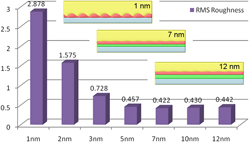Article contents
Effects of buffer layer thickness on the surface roughness of In0.3Ga0.7As thin films: A phase-field simulation
Published online by Cambridge University Press: 19 November 2013
Abstract

The graded composition buffer layers are very commonly used in the semiconductor triple-junction solar cell device. To grow a strain-free 1.0-eV In0.3Ga0.7As thin film on a GaAs substrate, a total of 2.2% misfit strain must be relaxed through well-designed buffer layer structures. In this work, a phase-field model of a multilayered system is developed to probe the roughness of top surface morphology and predict optimal buffer layer thickness. Our simulation shows time evolution of the thin film morphology and the root-mean-square roughness of the surface with different buffer layer thickness designs. The strain distribution is investigated to explain the surface morphology evolution with the effect of the buffer layer. The simulation results show that the buffer layer thickness is a key parameter that affects the quality of the In0.3Ga0.7As epilayers. The simulation results can be effective in improving the design of graded buffer layers.
- Type
- Articles
- Information
- Copyright
- Copyright © Materials Research Society 2013
References
REFERENCES
- 2
- Cited by


